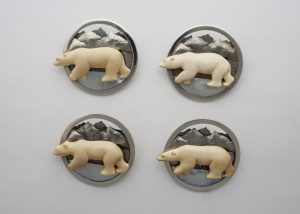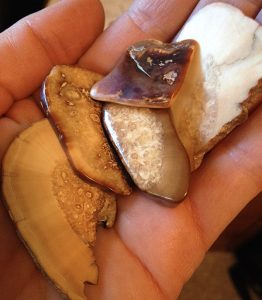At Zealandia Designs we specialize in making beautiful nature-inspired jewelry, primarily using ancient mammoth and fossilized walrus ivory. The naturally occurring colors of the ivory we use varies significantly from piece to piece, giving each one a truly unique appearance. The reason behind the coloration in fossilized ivory is an interesting one!
 “Vanishing Ice Cap” – made with ancient mammoth ivory[/caption]
Fossilized mammoth ivory tends to be shades of pale cream and white but can also be found in darker colors. Ancient walrus ivory, on the other hand, often appears in shades of cream, caramel, umber or cocoa. The display of color in the ivory enhances the piece by making it truly unique.
When a jewelry piece is created with fossilized ivory, it takes on a unique presentation that makes it one-of-a-kind. We encourage our customers to develop an eye for the different coloration in the fossilized ivory and appreciate how extraordinary it makes each piece. If you prefer an ivory that has more brown, cream or white tones to it, please be sure to let us know and we’ll do our best to accommodate if the option is available for that style. This can be particularly fun when it comes to certain pieces, like our cat collection – most folks would want to match their favorite feline, right? Look how widely the coloring varies in these cats:
[caption id="attachment_220" align="aligncenter" width="348"]
“Vanishing Ice Cap” – made with ancient mammoth ivory[/caption]
Fossilized mammoth ivory tends to be shades of pale cream and white but can also be found in darker colors. Ancient walrus ivory, on the other hand, often appears in shades of cream, caramel, umber or cocoa. The display of color in the ivory enhances the piece by making it truly unique.
When a jewelry piece is created with fossilized ivory, it takes on a unique presentation that makes it one-of-a-kind. We encourage our customers to develop an eye for the different coloration in the fossilized ivory and appreciate how extraordinary it makes each piece. If you prefer an ivory that has more brown, cream or white tones to it, please be sure to let us know and we’ll do our best to accommodate if the option is available for that style. This can be particularly fun when it comes to certain pieces, like our cat collection – most folks would want to match their favorite feline, right? Look how widely the coloring varies in these cats:
[caption id="attachment_220" align="aligncenter" width="348"] “Mischief” – made with fossilized walrus ivory[/caption]
Here is another style, in fossilized mammoth like the light colored polar bears, but with a wider variety of coloration:
[caption id="attachment_221" align="aligncenter" width="348"]
“Mischief” – made with fossilized walrus ivory[/caption]
Here is another style, in fossilized mammoth like the light colored polar bears, but with a wider variety of coloration:
[caption id="attachment_221" align="aligncenter" width="348"] “Turtle Spirit” – made with ancient mammoth ivory[/caption]
“Turtle Spirit” – made with ancient mammoth ivory[/caption]
 Fossilized walrus ivory from a buying trip to St. Lawrence[/caption]
Fossilized walrus ivory from a buying trip to St. Lawrence[/caption]
What is the difference between fossilized mammoth and walrus ivory?
Sometimes a certain design is specifically suited to a darker or lighter color and we purposely choose which kind of ivory is used. For example, when it comes to the polar bear pieces, we want them to be relatively consistent shades of creamy white, so we prefer to use only pale colored fossilized mammoth ivory. If you look closely, you can still certainly see different patterns and textures in this ivory, but the overall coloring is quite similar. [caption id="attachment_222" align="aligncenter" width="348"] “Vanishing Ice Cap” – made with ancient mammoth ivory[/caption]
Fossilized mammoth ivory tends to be shades of pale cream and white but can also be found in darker colors. Ancient walrus ivory, on the other hand, often appears in shades of cream, caramel, umber or cocoa. The display of color in the ivory enhances the piece by making it truly unique.
When a jewelry piece is created with fossilized ivory, it takes on a unique presentation that makes it one-of-a-kind. We encourage our customers to develop an eye for the different coloration in the fossilized ivory and appreciate how extraordinary it makes each piece. If you prefer an ivory that has more brown, cream or white tones to it, please be sure to let us know and we’ll do our best to accommodate if the option is available for that style. This can be particularly fun when it comes to certain pieces, like our cat collection – most folks would want to match their favorite feline, right? Look how widely the coloring varies in these cats:
[caption id="attachment_220" align="aligncenter" width="348"]
“Vanishing Ice Cap” – made with ancient mammoth ivory[/caption]
Fossilized mammoth ivory tends to be shades of pale cream and white but can also be found in darker colors. Ancient walrus ivory, on the other hand, often appears in shades of cream, caramel, umber or cocoa. The display of color in the ivory enhances the piece by making it truly unique.
When a jewelry piece is created with fossilized ivory, it takes on a unique presentation that makes it one-of-a-kind. We encourage our customers to develop an eye for the different coloration in the fossilized ivory and appreciate how extraordinary it makes each piece. If you prefer an ivory that has more brown, cream or white tones to it, please be sure to let us know and we’ll do our best to accommodate if the option is available for that style. This can be particularly fun when it comes to certain pieces, like our cat collection – most folks would want to match their favorite feline, right? Look how widely the coloring varies in these cats:
[caption id="attachment_220" align="aligncenter" width="348"] “Mischief” – made with fossilized walrus ivory[/caption]
Here is another style, in fossilized mammoth like the light colored polar bears, but with a wider variety of coloration:
[caption id="attachment_221" align="aligncenter" width="348"]
“Mischief” – made with fossilized walrus ivory[/caption]
Here is another style, in fossilized mammoth like the light colored polar bears, but with a wider variety of coloration:
[caption id="attachment_221" align="aligncenter" width="348"] “Turtle Spirit” – made with ancient mammoth ivory[/caption]
“Turtle Spirit” – made with ancient mammoth ivory[/caption]
What causes the different coloration in fossilized ivory?
Fossilized ivory spends most of its long life underground, in close contact with a variety of minerals. The minerals leech into the ivory, causing it to slowly accrete coloration. Depending on the immediate soil surrounding the animal and the length of time it was buried, the mineralization of the ivory takes on different hues of brown, tan, beige, and grey. Minerals and related color hues: carbon – black cobalt – green/blue chromium – green/blue copper – green/blue iron oxides – red, brown, and yellow manganese – pink/orange manganese oxides – blackWhere does our fossilized walrus ivory come from?
The native Yupik of St. Lawrence Island, Alaska, have the exclusive right to gather the fossilized walrus ivory we use in our designs. This precious ancient material is an important part of the Yupik's economy and heritage, and it is the inspiration behind many of our most beloved jewelry pieces. After centuries lying buried in darkness, it comes to light in these gorgeous designs that showcases the varied coloration in fossilized ivory. Each piece is hand carved, with uniquely pigmented ivory, resulting in an exceptionally original piece of jewelry. [caption id="attachment_169" align="alignleft" width="262"] Fossilized walrus ivory from a buying trip to St. Lawrence[/caption]
Fossilized walrus ivory from a buying trip to St. Lawrence[/caption]

1 Comment